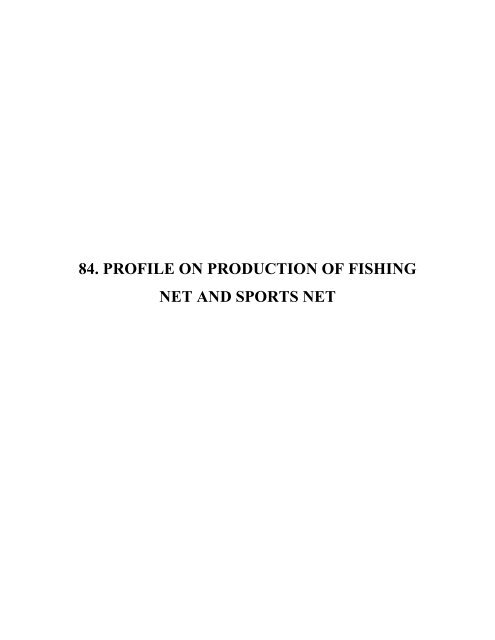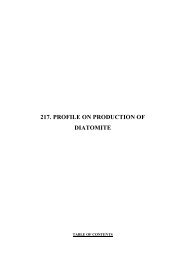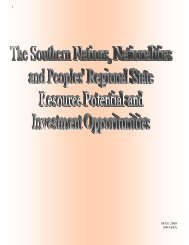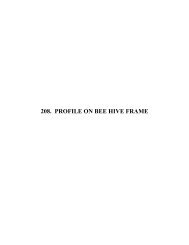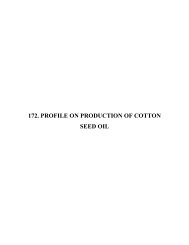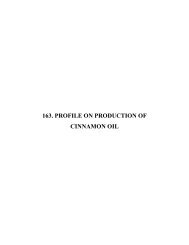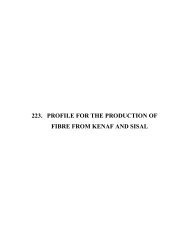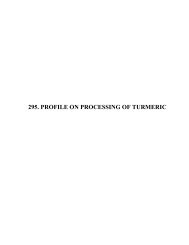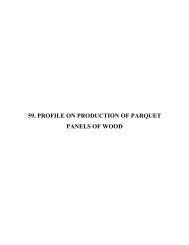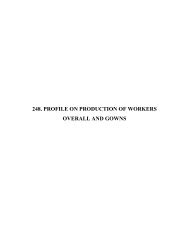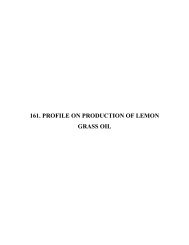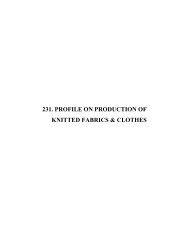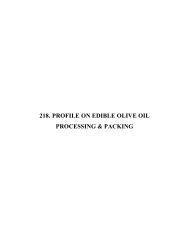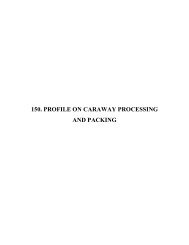PROFILE ON PRODUCTION OF FISHING NET AND SPORTS NET
PROFILE ON PRODUCTION OF FISHING NET AND SPORTS NET
PROFILE ON PRODUCTION OF FISHING NET AND SPORTS NET
Create successful ePaper yourself
Turn your PDF publications into a flip-book with our unique Google optimized e-Paper software.
84. <strong>PR<strong>OF</strong>ILE</strong> <strong>ON</strong> PRODUCTI<strong>ON</strong> <strong>OF</strong> <strong>FISHING</strong><strong>NET</strong> <strong>AND</strong> <strong>SPORTS</strong> <strong>NET</strong>
84-2TABLE <strong>OF</strong> C<strong>ON</strong>TENTSPAGEI. SUMMARY 84-3II. PRODUCT DESCRIPTI<strong>ON</strong> & APPLICATI<strong>ON</strong> 84-3III. MARKET STUDY <strong>AND</strong> PLANT CAPACITY 84-3A. MARKET STUDY 84-4B. PLANT CAPACITY & PRODUCTI<strong>ON</strong> PROGRAMME 84-4IV. MATERIALS <strong>AND</strong> INPUTS 84-7A. RAW MATERIALS 84-7B. UTILITIES 84-8V. TECHNOLOGY & ENGINEERING 84-8A. TECHNOLOGY 84-8B. ENGINEERING 84-10VI. MANPOWER & TRAINING REQUIREMENT 84-11A. MANPOWER REQUIREMENT 84-11B. TRAINING REQUIREMENT 84-12VII. FINANCIAL ANALYSIS 84-13A. TOTAL INITIAL INVESTMENT COST 84-13B. PRODUCTI<strong>ON</strong> COST 84-14C. FINANCIAL EVALUATI<strong>ON</strong> 84-15D. EC<strong>ON</strong>OMIC BENEFITS 84-16
84-3I. SUMMARYThis profile envisages the establishment of a plant for the production of fishing and sportnet with a capacity of 17 tonnes per annum.The present demand for the proposed product is estimated at 17.31 tonnes per annum.The demand is expected to reach at 36.67 tonnes by the year 2017.The plant will create employment opportunities for 37 persons.The total investment requirement is estimated at about Birr 10.32 million, out of whichBirr 6.90 million is required for plant and machinery.The project is financially viable with an internal rate of return (IRR) of 21.45 % and anet present value (NPV) of Birr 5.17 million discounted at 8.5%.II.PRODUCT DESCRIPTI<strong>ON</strong> <strong>AND</strong> APPLICATI<strong>ON</strong>The manufacture of fishing and sport net are made by twisting many filaments.Polyethylene filament having 300 to 800 denier is usually extruded. The tensile strengthof a 3,000 denier polypropylene filament is 5 to 7.5 g/denier. With these filaments asbasic materials, fishing net, fishing string, sport net, rope, etc. are manufactured.The fishing net is used to catching fish and sport net is used for catching the ball whenthe ball kicks in to the goal. Sport nets include nets for soccer, volleyball, basket ball,table tennis, ground tennis, hockey, football etc.
84-4III.MARKET STUDY <strong>AND</strong> PLANT CAPACITYA. MARKET STUDY1. Past Supply and Present DemandFishing nets are used for fish catching. Fish is highly nutritious, rich in micro-nutrients,minerals, essential fatty acids and protein. In many countries including Ethiopia theaverage per capita fish consumption is as low as up to two kilogrammes per year.The global demand for fishes is growing as urban population increases and incomegrows. The global fish supply increased from 45 million metric ton in 1873 to 91 millionton in 1997. Rapid urbanization along with increase in the average amount of fishconsumption per head led to soaring increase in global fish consumption.Inland fisheries status is difficult for assessment, catch rates being dependent onseasonality. Globally, inland fishery resources appear to be continuing to decline as aresult of habitat degradation and over fishing.According to FAO’s world fish production statistics of 2004, Ethiopia’s captureproduction was 10,005 tons. Most fisheries in Ethiopia could be classified as small scale,labour intensive, using small crafts and little capital and equipment per person-on boardtype.
84-5Table 3.1IMPORTED <strong>FISHING</strong> <strong>NET</strong>S <strong>AND</strong> KNOTTED <strong>NET</strong>TING PRODUCTSYear Import (Kg)1998 8,7981999 7,5042000 6922001 2,6472002 13,1072003 5962004 1,5322005 13,2782006 9,162Source: Customs Authority.Sports nets are used in games like soccer, basket ball, handball etc. where the ball rests orpasses through the net as players score against the other team.There is no official statistics on the supply of nets produced in the country. However it isa well known fact that nets are produced at home for own used and for commercialpurposes of limited scope. On the other hand there are imported nets in the market.Import of netting products is presented in Table 3.1.The average annual import of made up fishing nets for the last ten years was 9,434 kg. Inaddition to this 4,728 kg knotted netting of twine, cordage or rope was imported annually.The total netting products imported was therefore 6,369 kg per year. A closer look at themarket confirms that imported nets cover about 40% of the total supply of nets sincevariety of synthetic yarns are available and abundant in the market, home made netssupply is believed to cover 60% of the supply. Therefore the current effective demandfor fishing nets and sports nets is estimated to be 15,923 kg.
84-62. Projected DemandThe demand for fishing nets is directly related with the production of fisheries. As a landlocked country the Ethiopian current fish production is made at rivers and lakes. Thoughin the long run the resources of inland fish are known to be declining in the short runthere is a potential of growth in the supply. In addition to the demand for fishing nets,sports nets will contribute to the growth of net production and supply. Sport activities inschools, clubs, institutions and the public in general is improving and will continue toadvance along with the growth in standard of living. Therefore the annual GDP growthrate of 2004/5 is assumed in the projection of the demand for nets. Projected demand fornets is presented in Table 3.2.Table 3.2PROJECTED DEM<strong>AND</strong> FOR <strong>NET</strong>S (KG)Year Projected Demand2008 17,3082009 18,8142010 20,4512011 22,2302012 24,1642013 26,2662014 28,5552015 31,0352016 33,7352017 36,670
84-73. Pricing and DistributionBased on CIF price of the products a factory get price of Birr 200 per kg isrecommended. Super markets, stores, sport equipment shops are the main outlets for theproduct.B. PLANT CAPACITY <strong>AND</strong> PRODUCTI<strong>ON</strong> PROGRAMME1. Plant CapacityBased on the market study, the annual rated capacity of the plant will be 17 tonnes. Theplant is expected to operate 8 hours a day in a two shift for a total of 300 days a year.2. Production ProgrammeIt is anticipated that the plant will run at 70% of its capacity during the first year, at 85%in the second year and at full capacity in the third year and then after.IV.MATERIALS <strong>AND</strong> INPUTSA. RAW MATERIALSThe main material required for the production of fishing and sport net is Polypropyleneand/or HDPE. The raw material can not be available locally. Thus it should be imported.The estimated annual cost of raw material at 100% capacity utilization is birr given inTable 4.1.
84-8Table 4.1ESTIMATED ANNUAL COST <strong>OF</strong> MATERIAL INPUTSSr.Cost, 000 BirrNo. Description Qty Foreign Local Total1 Polypropylene 17 tones 131.56 26.31 157.87Total - 131.56 26.31 157.87B. UTILITIESUtilities required are electricity and cooling water. The annual quantities and cost ofutilities are estimated as shown in Table 4.2.Table 4.2ANNUAL UTILITY REQUIREMENT <strong>AND</strong> COSTSr.NoDescription Qty Cost, OOOBirr1 Electric Power 96,700 kWh 45.782 Water 1,000 m 3 10.00Total 55.78V. TECHNOLOGY <strong>AND</strong> ENGINEERINGA. TECHNOLOGY1. Production ProcessRaw material is fed to extruder and form a plastic filament and are cooled and solidifiedin the quenching bath. After going different roller bath and are stretched, themonofilaments are annealed in the subsequent annealing bath. Each filament is wound
84-9round the winder bobbin. The thickness of a monofilament is decided on according to itsuse, and is also controlled by the extruding rate of the extruder and by stretching ratio.The monofilament bobbin is set on the 4-spindle strander S-type creel stand, and a fixednumber of monofilaments are twisted by 4-spindle strander. The twines are then rewoundround the balling machine, and become fishing net.A fixed number of monofilaments are twisted by the ring doubling flame on the creelstand. As the first yarns thus produced are still thin, a fixed number of yarns are set on thedies twister creel and are twisted to become a second yarns. The second yarns are set onthe strander, and strands are produced by twisting a fixed number of the second yarns.Three strands bobbins are set on the rope layer and sport nets are produced by twistingthe three strands.2. Source of TechnologyThe technology of Fishing & Sport nets can be obtained from How to start file:B2-ISIC3215. The equipment can be supplied from Europe, Far East or India. Contact can bemade with the following suppliers:i) Glory CorporationCPO Box 9265SEOUL, KOREAEmail:adm@gloryco.comTel: 82-2-786-8746-8Fax: 82-2-786-8749
84-10B. ENGINEERING1. Machinery and EquipmentThe production equipment required by the plant and their estimated costs are given inTable 5.1.Table 5.1MACHINERY & EQUIPMENT REQUIREMENT & ESTIMATED COSTSr.Cost, ( OOO Birr)No Qty F.C L.C Total12345678ExtruderRope twisterSpindle StranderBobbin StranderBobbin CloserHigh speed cylinder typetandem lead MachineBalling Machine2 Set2 Set6 Set2 Set1 Set1 set11Rope Coiling MachineTotal - 5,750,000.00 5,750,000.00Insurance, Customs Duty,Inland Transport, Bank- 1,150,000.00 1,150,000.00Charge, etc.Grand Total 5,750,000.00 1,150,000.00 6,900,000.00
84-112. Land, Building and Civil WorksThe processing building requires a steel structure covered with EGA sheet roof, HCBwall, and cement screed floor finish. The total area of land required is estimated to be2,500 m 2 , out of which 800 m 2 will be built-up area. The cost of land at the rate of Birr0.625 per square meter and for 80 years of land lease will amount to Birr 125,000.00 Thetotal cost of building and civil works at the unit cost of Birr 2,300 per m 2 is estimated atBirr 1,840,000.003. Proposed LocationThe plant should be located where the raw material, infrastructure, power and utility areavailable. Hence, the plant is proposed to be located in Arba Minch/ Dilla/Welaita sodoor Hosana.VI.MANPOWER <strong>AND</strong> TRAINING REQUIREMENTA. MANPOWER REQUIREMENTThe total manpower requirement of the plant is 22 persons. Details of manpower andestimated annual labor cost including fringe benefits are indicated in Table 6.1.
84-12Table 6.1MANPOWER REQUIREMENT <strong>AND</strong> ESTIMATED LABOUR COSTSr. Req. Salary, BirrNo. Job Title No Monthly Annual1 General Manager 1 2,500 30,0002 Secretary 1 800 9,6003 Technical & Production Manager 1 1,800 21,6004 Finance and Administration head 1 1,800 21,6005 Sales person 1 700 8,4006 Store keeper 1 700 8,4007 Purchaser 1 600 7,2008 Accountant/Cashier 1 750 9,0009 Driver 1 400 480010 Production 14 5600 6720011 Laborers 10 3,000 2400011 Guard 4 2000 9,600Total 37 221400Employees’ Benefit (25% of Basic Salary) - 55350Grand Total - 276750B. TRAINING REQUIREMENTThe production supervisor should be given a three weeks on-the-job training by skilledtechnician of the equipment supplier. The cost of training is estimated at Birr 50,000.
84-13VII. FINANCIAL ANALYSISThe financial analysis of the fishing and sport nets project is based on the data presentedin the previous chapters and the following assumptions:-Construction period1 yearSource of finance30 % equity70 % loanTax holidays5 yearsBank interest 8.5 %Discount cash flow 8.5 %Accounts receivable30 daysRaw material local30 daysRaw material, import90 daysWork in progress2 daysFinished products30 daysCash in hand5 daysAccounts payable30 daysA. TOTAL INITIAL INVESTMENT COSTThe total investment cost of the project including working capital is estimated at Birr10.32 million, of which 56 per cent will be required in foreign currency.The major breakdown of the total initial investment cost is shown in Table 7.1.
84-14Table 7.1INITIAL INVESTMENT COSTSr.No.Cost ItemsTotal Cost(‘000 Birr)1 Land lease value 1252. Building and Civil Work 18403. Plant Machinery and Equipment 69004. Office Furniture and Equipment 505. Vehicle 2006. Pre-production Expenditure* 1119.147 Working Capital 89.62Total Investment cost 10324Foreign Share 56.18* N.B Pre-production expenditure includes interest during construction ( Birr 603.39 thousand ) training(Birr 50 thousand ) and Birr 465.75 thousand costs of registration, licensing and formation of thecompany including legal fees, commissioning expenses, etc.B. PRODUCTI<strong>ON</strong> COSTThe annual production cost at full operation capacity is estimated at Birr 1.97million (see Table 7.2). The material and utility cost accounts for 10.83 per cent, whilerepair and maintenance take 7.61 per cent of the production cost.
84-15Table 7.2ANNUAL PRODUCTI<strong>ON</strong> COST AT FULL CAPACITY ('000 BIRR)Items Cost %Raw Material and Inputs 157.87 8.00Utilities 55.78 2.83Maintenance and repair 150 7.61Labour direct 141 7.15Administration Costs 135.78 6.88Total Operating Costs 640.40 32.47Depreciation 930.15 47.18Cost of Finance 401.15 20.35Total Production Cost 1971.70 100C. FINANCIAL EVALUATI<strong>ON</strong>1. ProfitabilityAccording to the projected income statement, the project will start generating profit in thefirst year of operation. Important ratios such as profit to total sales, net profit to equity(Return on equity) and net profit plus interest on total investment (return on totalinvestment) show an increasing trend during the life-time of the project.The income statement and the other indicators of profitability show that the project isviable.
84-162. Break-even AnalysisThe break-even point of the project including cost of finance when it starts to operate atfull capacity ( year 3 ) is estimated by using income statement projection.BE = Fixed Cost = 51 %Sales – Variable Cost3. Pay Back PeriodThe investment cost and income statement projection are used to project the pay-backperiod. The project’s initial investment will be fully recovered within 4 years.4. Internal Rate of Return and Net Present ValueBased on the cash flow statement, the calculated IRR of the project is 21 % and the netpresent value at 8.5 % discount rate is Birr 5.17 million.D. EC<strong>ON</strong>OMIC BENEFITSThe project can create employment for 37 persons. In addition to supply of thedomestic needs, the project will generate Birr 5.19 million in terms of tax revenue. Theestablishment of such factory will have a foreign exchange saving effect to the country bysubstituting the current imports.


